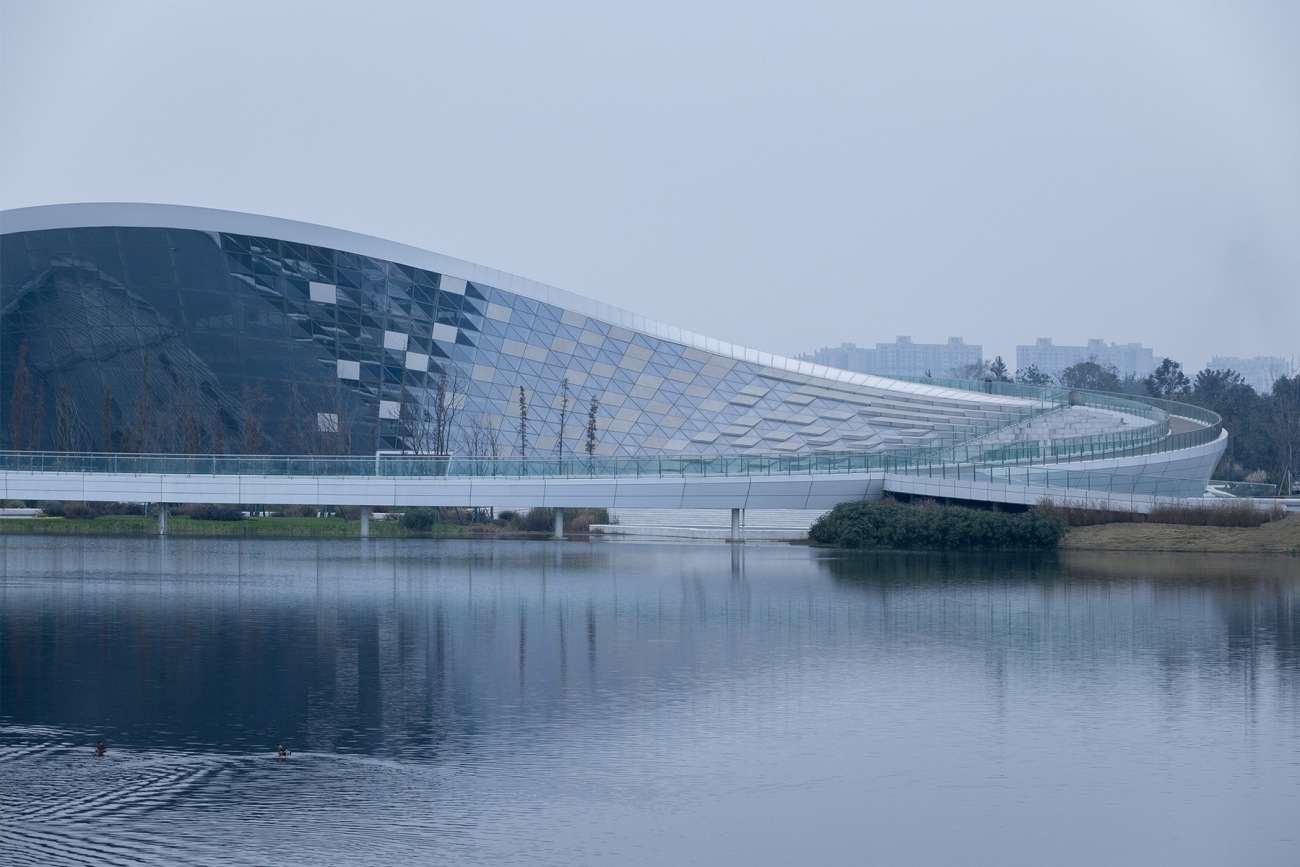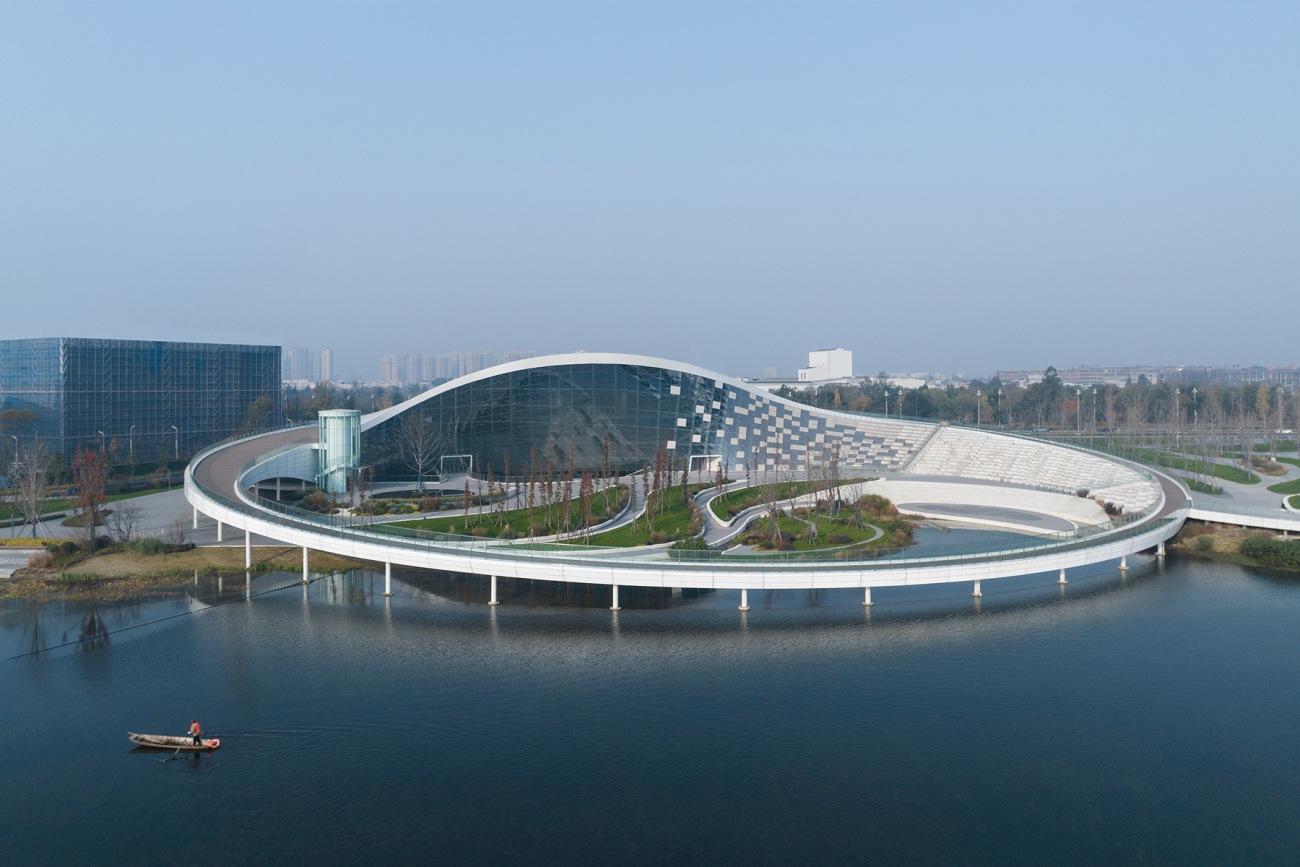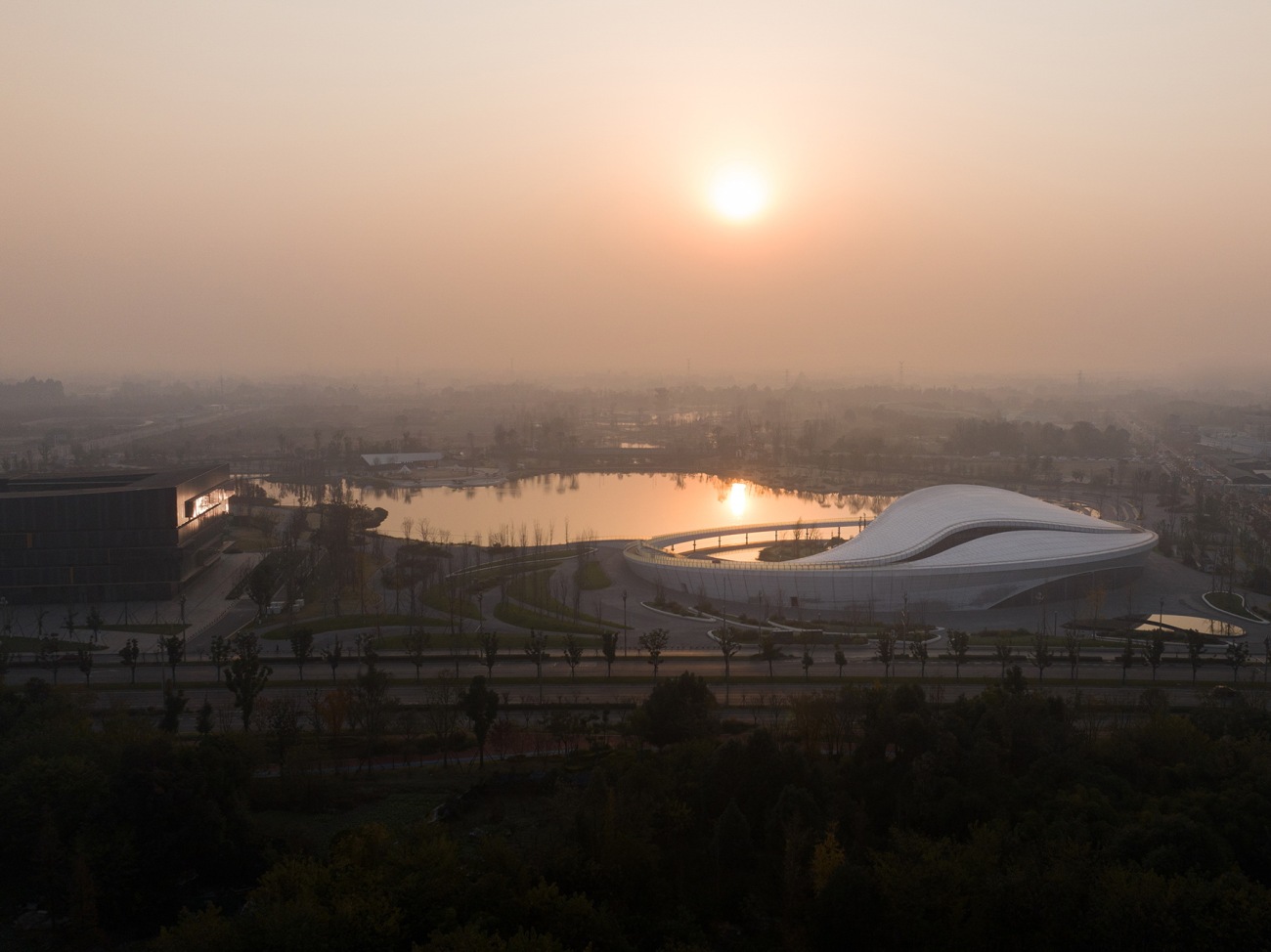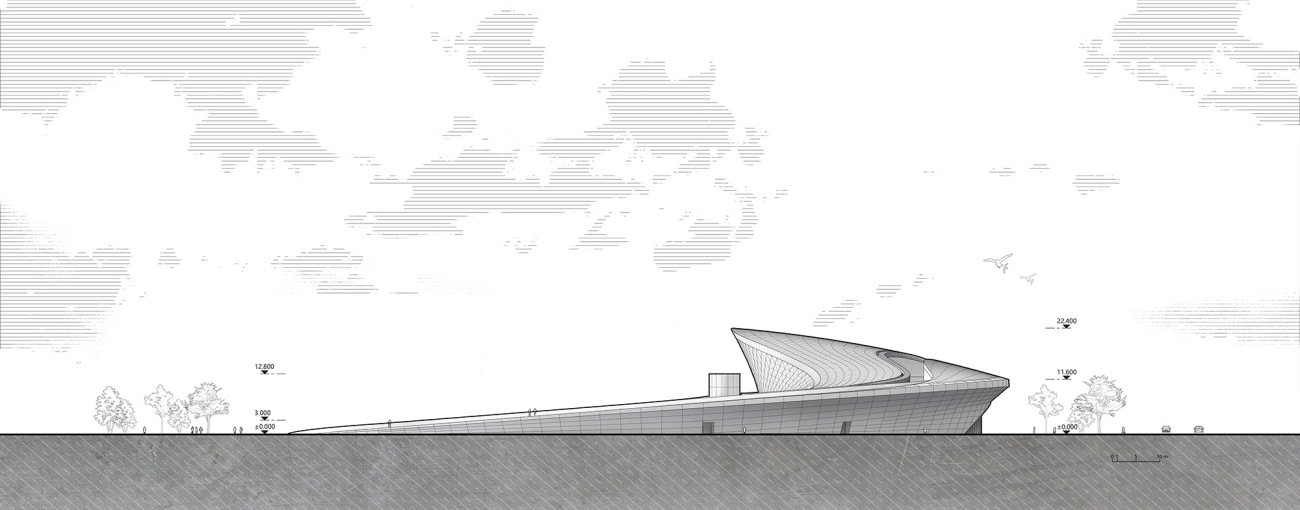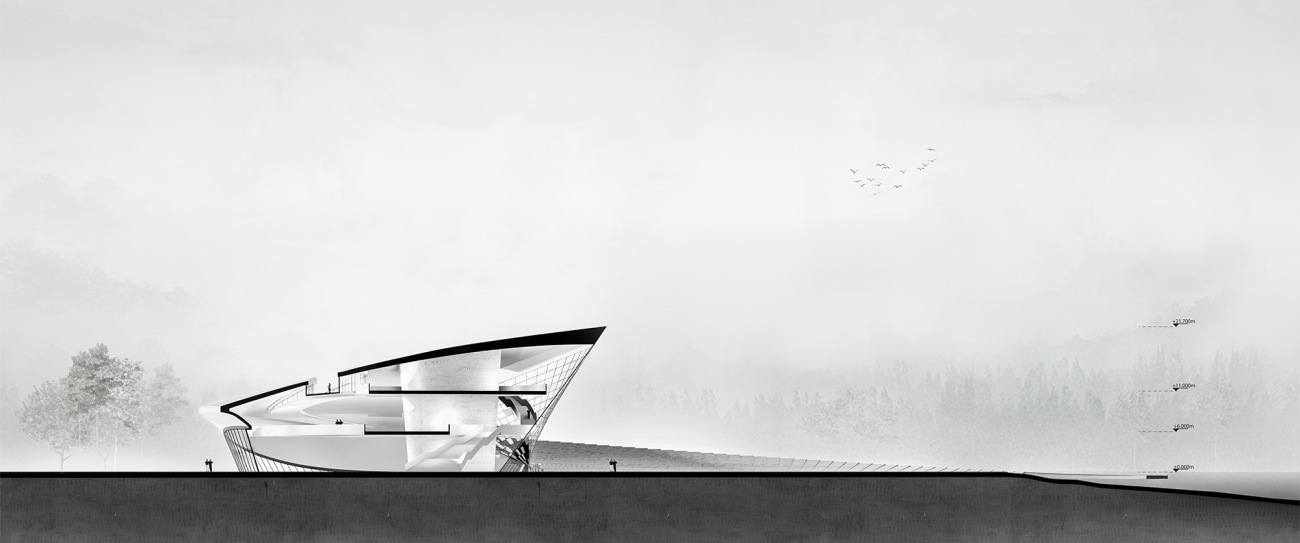“万物负阴而抱阳,冲气以为和”
—— 《道德经》
夕阳下的湖岸博物馆TCM Museum at Sunset
‖ 项目背景 Project Background
2020年3月,由卢昀带领的MUDA慕达建筑事务所,为成都彭州市设计打造天府中医药博物馆。彭州是成都北向交通门户枢纽,具有丰富的动植物药材资源。作为全国最大的川芎产业标准化示范基地,彭州聚集了近90家医药健康企业。为积极响应国家中医药振兴发展战略,2019年以四川彭州工业园区为基础规划建设,正式设立天府中药城。
In March 2020, led by Lu Yun, MUDA-Architects designed the Museum of Tianfu Traditional Chinese Medicine for Pengzhou City. Being the northern transportation hub of Chengdu, Pengzhou possesses abundant resources of medicinal herbs, it has drawn more than 90 pharmaceutical companies as the largest ligusticum striatum industry standardization production demonstration base. In response to the national strategy of revitalizing traditional Chinese medicine, in 2019, Tianfu Traditional Chinese Medicine City was officially established based on the Pengzhou Industrial Park in Sichuan.
鸟瞰 Aerial View
自然,建筑与人和谐共荣 Nature, Architecture, and Humanity Harmoniously Thrive Together
天府中医药博物馆位于彭州天府中药城起步区内,规划建设用地面积约1.3万平方米。场地东侧为汇通湖,西侧紧临三环路,交通便利。博物馆建成后成为天府中药城的标志性建筑,为诠释中医药文化、展示当地医药生态价值、传播中医药知识起到积极作用,同时回应公园城市的宏观理念。
The 13,000 square meter TCM museum, which is in the heart of TCM City, is close to Huitong Lake to the east and the third ring road to the west. Taking advantage of the location, the TCM Museum aims to construct a spiritual emblem for the region, create a synthesis of culture and ecology, reinvigorate and disseminate traditional Chinese medicine knowledge, and respond to the Park City development in a broader context.
落日余晖中的博物馆 TCM Museum at Sunset
‖ 设计理念 Design Concept
中国传统中医历史悠久,具有完整的理论体系,强调“天人合一”、“天人相应”的整体观及辨证论治,认为自然由阴阳两大类物质构成,阴阳二气既相互对立而又相互依存,并时刻都在有规律的运动与变化之中。
Chinese traditional medicine has undergone a long course of development with a complete theoretical system, emphasizing the holistic view of "unity of nature and humanity" and the dialectical treatment. Traditional Chinese medicine stresses the harmony and correspondence between humans and nature, believing that humanity is a component of the entire nature that is constituted by ‘Yin’ and ‘Yang’ in dualism: mutually antagonistic yet interdependent, and constantly undergo regular movement and change.
设计概念Design Concept
古人对这一哲学思想,用太极图作了极致的概括。太极图形象地表达了阴阳轮转、相辅相成是万物生成变化的根源,也展现了一种互相转化、相对统一的形式之美、和谐之美。
Our ancestors thought of Yin and Yang as being perpetually complementing and interdependent in a dynamic situation, and they used the Taiji diagram to vividly depict such a viewpoint: the complementary nature of all things, which is the root of generation and change, and a form of mutual transformation, relative unity, and harmonious beauty.
场地鸟瞰_Aerial View of Site
相辅相成的建筑与景观Complementary Architecture and Landscape
MUDA慕达建筑从中医哲学中汲取灵感,从“整体与辩证”的思想出发,引阴与阳为概念,生成空间的虚与实。以虚实相生的手法,旨在将人、建筑、城市与自然融合,展现中国传统文化中医的理念和底蕴,体现万物归一的自然观。
MUDA-Architects draws inspiration from traditional Chinese medicine philosophy, starting from the concept of "wholeness and dialectics," and impregnated the concept of Yin-Yang theory to bring forth the design into a void-solid combination of spaces generated by the conceived architecture and landscape. The scheme captures the essence of traditional Chinese medicine and harmoniously incorporates its underlying, antiquated philosophy into the design of architecture, landscape, and nature from a large-scale perspective, as well as material design, interior spaces, and human from a micro level.
清晨薄雾中的博物馆_The Museum in the Morning Mist
建筑与水域相融 The Integration of Architecture with Waterscape
‖ 建筑-虚实统一 Architecture: Solid and Void
俯瞰整个中医药博物馆,圆形建筑主体与场地水域景观结合,形如太极。建筑为实,景观为虚;陆地为阳,水域为阴,阴阳虚实被圆形环道紧密串联并围合其中。流动的水与行走的人,为静态的建筑增添动势与生机,动静结合,天人合一。天,地,人, 在此相辅相融,诠释了MUDA慕达建筑对自然万物和谐统一的理解。
The circular walkway encloses the museum's main structure and the surrounding waterscape, which resemble the form of Taiji. The substantial structures with the vacuous landscape, and the‘positive’earth with the‘negative ’water, are ways that the principle of Yin and Yang is expressed. Yin and yang, solidity and void, are closely linked and enclosed by a circular ring road. Walking people and flowing water bring the still architecture energy and propulsion, fusing motion and stillness to bring together people and the environment. Heaven, earth, and humanity blend here, interpreting MUDA Architecture's understanding of the harmonious unity of nature and all things.
环道与行人为建筑增添动势与生机The Circulatory Pathways and Pedestrians Infuse Dynamism and Vitality into the Architecture
阴阳虚实被圆形环道围合其中
Yin & Yang is enclosed within the circular pathway
博物馆主入口位于场地西侧,入口景观广场将城市主干道与建筑有效连接。入口西立面主要采用穿孔铝板,阻挡西晒以减少能源消耗,建筑立面曲线也丰富城市界面。东立面朝向湖区景观,采用高透双曲面玻璃幕墙,最大化地将自然景观引入室内,打破建筑与自然的边界。
The museum's main entrance is situated on the west façade, and a landscaped plaza connects it to the major city street. Curved perforated aluminum panels are mostly used on the entrance's west façade to enhance the urban cityscape and to shield the western sun to lower energy consumption. The east façade of the building, which faces the lake, has a double-curved glass curtain wall that break the boundaries between architecture and landscape.
通往博物馆的道旁景色 The Scenery Along the Pathway Leading to the Museum
与建筑相容的景观Landscape Design Compatible with the Architecture
‖ 室内-混沌有序 Interior:Yin within Yang
建筑最高点22.4米,分为地上三层和地下一层。首层以公共空间为主,分布入口大厅、报告厅、互动展厅、咖啡餐饮等。二、三层以展览为主,分布中医药展厅、科技文化展厅及中医药工作室。地下一层以停车及配套为主,结合下沉广场设置商业互动空间,拥有极高的灵活性,提供多种活动的可能。
The structure is 22.4 meters at its highest point, constitutes of three stories above ground and one underground level. The majority of the public areas, including the entrance hall, lecture hall, interactive exhibition area, coffee,and catering area, are located on the ground floor. The primary display area, which is organized into TCM exhibitions, science and technology exhibitions, and TCM workshops, is set on the second and third floors. Parking area and utilities are on the underground floor. Additionally, the underground area combines with the exterior sunken plaza to provide interactive and commercial spaces, offering a flexible range of recreation activities to the public.
灵活的下沉广场互动空间Flexible Sunken Plaza Interactive Space
下沉广场 the Sunken Plaza
倒映在建筑里面上的山水长卷The Landscape Scroll Reflected on Building Facade
建筑入口即为三层通高的中庭,多层次的曲线平台丰富了内部空间,也为后期展陈提供了多种可能。天窗与通透的玻璃幕墙将阳光与生态景观引入室内,参观者在各层的高度都能以不同的视角与自然产生互动。室内空间延续建筑设计理念,将整体形态蜿蜒流动的曲线延伸到室内,空间的各个要素有机地交织在一起,虚实相间,混沌有序。
Multi-level curved platform in the three-storey entrance hall enriches the interior space and providing various possibilities for later exhibitions. Skylights and transparent glass curtain walls introduce sunlight and ecological landscape into the interior, allowing visitors to interact with nature from different perspectives on each floor. The winding and flowing curves of the architectural concept are carried into the interior space, continuing the design motif. The many components of the room are organically interwoven together to create order within chaos, Yin within Yang.
东立面通透的玻璃幕墙East Facade with Transparent Glass Curtain Wall
建筑框景Architectural Framing
双曲面玻璃幕墙Double-curved Glass Curtain Wall
‖ 景观-混元一气 Landscape: Order within Chaos
全区景观以中医药博物馆为核心,建筑本体、流线型的景观绿地、环形连廊围合的内部水域和广场、水上岛屿等元素,共同构成了城市的第五立面,宛如一张巨大的太极图。其充满动势,带动周边环境,形成一团巨大的混元体在进行有序的混化运动。
The TCM Museum is the focal point of the overall landscape design. The architectural body, the undulating landscape area, the water islands, the waterscape, and the public plaza enclosed by the circular walkway, all components of the complex constitute the fifth façade of the TCM city, simulate a gigantic Taiji diagram in continuous motion. The entire complex driving the surrounding environment with its dymism, combines Yin and Yang, and transforms chaos into deliberate order.
总平面图_Master Plan
流线型的景观绿地Streamlined Landscape Greenery
建筑与景观和水域的虚实相间The Interplay of Void and Solid Between Architecture,Landscape, and Water
景观语言应运而生,运动的混元之气转化成起伏绿地、曲线水景,围绕着中心建筑旋转,静态曲线仿佛有了动态之势。混元是天地之大道,其大无外,其小无内,既包含宇宙的运化规律,又隐现人生的本根,天地人混元一体,与中医思想里的整体、阴阳、平衡不谋而合。
The movement of the hybrid energy was transformed into undulating green space and curving waterscape, which is constantly rotating around the main building structure. The design of the landscape impregnated both the laws of the nature and the foundation of life, heaven, earth, and human beings are integrated into one, coinciding with the holistic, yin-yang, and balance concepts in traditional Chinese medicine.
粼粼微波中的建筑倒影和环形步道The building and circular pathway reflected in the glistening ripples
起伏的绿地景观环绕着建筑Undulating green landscape surrounds the building
阶梯、景观、和水中岛屿组成的户外剧场The outdoor theater composed of stairs, landscape, and islands
景观向全市民24小时开放,成为城市公园和公共空间,服务城市人群。其中四大景观系统:空间系统,创建起伏地形,绿地绵延,打造沉浸式自然氛围;步行系统,串联多条漫步流线,提供舒适而丰富的富氧之旅;植物系统,种植不同季节的中医药植物,科普知识,疗愈内心;艺术生活系统植入各种类型的艺术形式,预留更多灵活可变的艺术空间。漫步园区,不仅能学习中医药文化知识,亦能从精神上感受到中医的“混元”气运,做到内外调和。
the entrance of the landscape and circuit walkway is separated from the museum entrance and it offers 24/7 access for the public, thus providing a true public space for urban population. Among them, there are four main landscape systems: A plant system where different seasonal herbs are planted in designated areas for herbal knowledge education; a spatial system that creates undulating terrain and stretches of green space to create an immersive natural atmosphere; a pedestrian system that links multiple walking routes to provide a comfortable and oxygen-rich journey; an artistic living system that implants various types of art forms to reserve more flexible and variable art spaces. With its participatory, interactive and open atmosphere, the museum also acts as a public platform that accommodates exhibition, education, social interaction and experience of nature. Standing comfortably in its surroundings, one can achieve internal and external harmony.
空间的虚与实_The Interplay of Void and Solid in Space
贯穿建筑的环形步道_Circular Pathway Running Through the Building
24/7面向市民开放的广场和步道空间A plaza and pathway space open to the public 24/7
‖ 结语 The End
天府中医药博物馆作为天府中药城的标志性建筑,是整个园区的精神堡垒,不仅承载着千年传统中医药学的厚重历史,也是对未来中医药的传承和发展的期许。此次设计对于MUDA慕达建筑而言,是一次融合建筑、自然、城市与传统文化的尝试,也是一次思考中国传统哲学思想与当代建筑的契机。
As a landmark building of Tianfu Traditional Chinese Medicine City, the Tianfu Traditional Chinese Medicine Museum is the spiritual fortress of the entire park, bearing the heavy history of traditional Chinese medicine for thousands of years, and also the expectation of the future inheritance and development of Chinese medicine. The design, according to MUDA-Architects, is an effort to blend architecture, nature, the city, and traditional culture as well as a chance to speculate about traditional Chinese philosophy and contemporary architecture design. This design is a fusion of architecture, nature, urban cities, and traditional culture, as well as an opportunity for MUDA-Architects to reflect on traditional Chinese philosophy and contemporary architecture design.
建筑、自然、城市与传统文化的融合The integration of architecture, nature, urban elements, and traditional culture
宁静矗立湖畔的中医药博物馆The Chinese Medicine Museum nestled by the lakeside
夕阳余晖下的柔和金属光泽The gentle metallic luster under the sunset glow
夕阳下的湖岸博物馆_Museum at Sunset
一层平面图_First Floor Plan
二层平面图_Second Floor Plan
三层平面图_Third Floor Plan
负一层平面图_B1 Floor Plan
西立面_West Facade
东立面_East Facade
北立面_North Facade
南立面_South Facade
剖面图 Sectional Elevation
项目名称:天府中医药博物馆
项目类型:建筑设计、室内设计、景观设计
项目地点:中国 成都彭州
建筑面积: 13,245平方米
建筑事务所:MUDA慕达建筑
主持建筑师: 卢昀
设计团队:何帆、徐建丹、李昊、李爱东、付尧、荣典、柳斌、吕晨宇、詹子琪、程诗韵
业主单位:彭州市规划和自然资源局、成都濛江投资集团有限公司
幕墙设计顾问:成都几里创意幕墙
结构设计顾问:iStructure
建筑施工图设计:中国建筑西南设计研究院
建筑摄影:直译建筑摄影、存在建筑
Project Name: Tianfu Museum of Traditional Chinese Medicine
Project Type: Architectural Design, Interior Design, Landscape Design
Project Location: Pengzhou, Chengdu, China
Project Size: 13,245 square meters
Design Firm: MUDA-Architects
Principal Architects: Lu Yun,
Design Team: He Fan, Xu Jiandan, Li Hao, Li Aidong, Fu Yao, Rong Dian, Liu Bin, Lv Chenyu, Zhan Ziqi, Cheng Shiyun
Client: Pengzhou Planning and Natural Resources Bureau, Chengdu Mengjiang Investment Group Corp. Ltd
Curtain Wall Design Consultant: Ji Li Creative Curtain Wall
Structural Deisgn Consultant: iStructure
Building Construction Drawing:China Southwest Architectural Design and Research Institute Corp. Ltd
Photography:Archi-Translator,Arch-Exist
更新日期:2024-04-01 17:37:09
非常感谢 MUDA慕达建筑 带来的精彩项目, 查阅更多Appreciations towards MUDA-Architects for sharing wonderful work on hhlloo. Click to see more works!








